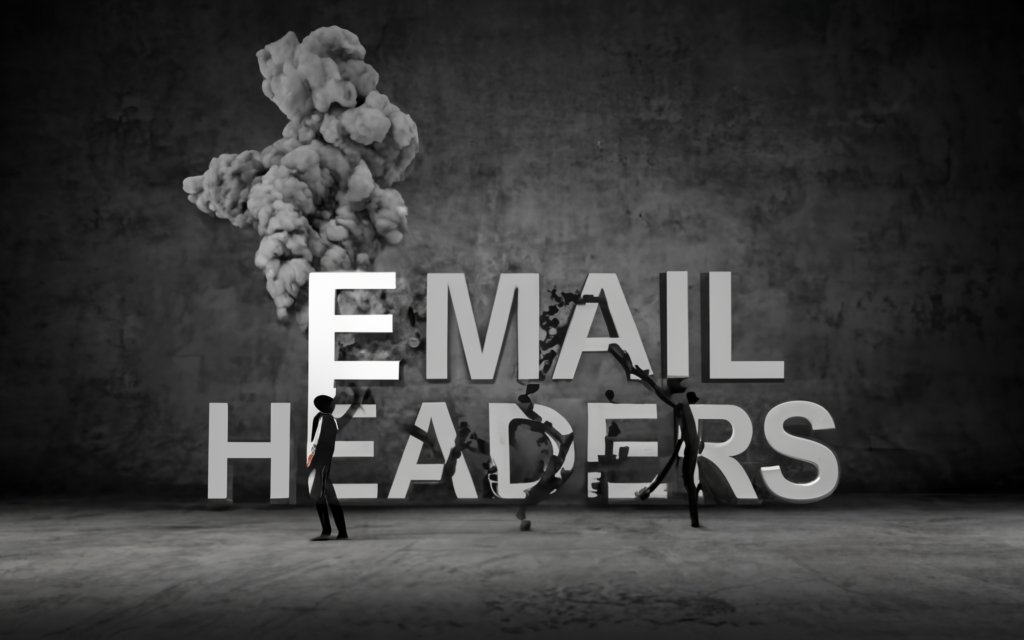Email headers contain a treasure trove of data for diagnosing delivery issues, avoiding phishing, and optimizing engagement. Yet few senders unlock their full potential. This comprehensive guide demystifies headers to help you troubleshoot and fine-tune email performance. Follow along for actionable techniques to leverage headers like a pro.
What are Email Headers and Why They Matter
Email headers are an essential part of every email, yet few people know how to access or understand them. This section will demystify email headers so you can leverage them for troubleshooting delivery issues and maximizing inbox placement.
An email header contains critical transmission details and serves as a “passport” to ensure smooth passage across networks. When your email reaches the recipient’s mail server, the first thing checked is – you guessed it – the header! So let’s dive in and unpack what headers are made up of and why they matter.
Anatomy of an Email Header
An email header provides the metadata that postal mail lacks. It includes details like:
To: The intended recipient’s email address.
From: The sender’s email address.
Subject: A summary of the content.
Date: When the email was composed and sent.
Received: Time and details for each network hop from sender to recipient.
Return-Path: Where bouncebacks should be directed.
These basic fields provide visibility into the email’s journey. But headers also contain crucial authentication mechanisms like DKIM and SPF that verify the email’s integrity.
Additionally, there are optional fields that senders can customize:
Reply-To: Alternate address for responses.
CC: Carbon copy recipients.
BCC: Blind carbon copy (hidden) recipients.
List-Unsubscribe: Opt-out link for marketing lists.
X-Headers: Custom fields like campaign IDs defined by the sender.
So in summary, headers both validate the “passport” of an email and provide flexibility to track and control messaging.
Envelope Sender vs Header From
One nuance in email headers is the difference between the envelope sender and the header from.
The envelope sender identifies the actual mailbox that submitted the email to the first mail server. This is used for bouncebacks but is not visible to recipients.
The header from indicates the domain and address displayed to recipients. For deliverability, these should ideally match. Misalignment can trigger spam filters.
Extracting and Reading Email Headers
Now that you know why headers matter, let’s cover the hands-on basics of retrieving and reading them.
The first step is accessing the full raw headers, which are hidden by default in most email clients. Here’s how for popular services:
Viewing Headers in Gmail
In Gmail, open the message and click the down arrow next to Reply. Choose Show Original.
You’ll see the raw source with full headers. Click Download Original to save the .eml file.
Viewing Headers in Outlook
In Outlook, double-click to open the message. Go to File > Properties.
Under Internet Headers, copy the full header text.
Viewing Headers in Yahoo
In Yahoo Mail, click the down arrow next to Reply and choose View Raw Message.
This displays the headers. Copy the full text.
Online Header Analysis Tools
Instead of deciphering headers manually, use tools like MXToolBox Header Analyzer. Just paste your full headers and it structures them neatly to spotlight issues.
Online tools parse headers instantaneously, saving huge time versus manual analysis.
As you can see, getting full headers takes just an extra click in major email services. With headers in hand, you unlock a powerful troubleshooting toolkit for email delivery diagnostics. Let’s explore how to leverage headers to their full potential.
Now that you can access full email headers, let’s explore advanced techniques to unlock their full potential.
Sophisticated header analysis provides insight into deliverability, security, and compliance. Mastering these skills takes time, but rewards you with a superpower for troubleshooting email issues.
This section will provide a framework for methodical header diagnostics along with tools to parse error codes and identify abnormalities.
Checklist for Analyzing Headers
When dissecting headers, use this checklist to catch common red flags:
Verify SPF and DKIM Authentication
Sender Policy Framework (SPF) and DomainKeys Identified Mail (DKIM) authenticate that incoming mail aligns with the sender’s published policies.
Failing SPF or DKIM validation is a big red flag, indicating potential spoofing. Check that both pass before further analysis.
Review DMARC Alignment
DMARC builds on SPF and DKIM to offer an extra policy layer for sender domains. “Reject” or “quarantine” policies mean improperly aligned mail gets blocked.
So verify the “From” domain matches the sender’s DMARC record to confirm deliverability.
Check Hop-by-Hop Tracking
The “Received” fields show each network hop from server to server. Review these to identify unusual routes, delays, or previously unseen mail servers.
Sudden changes may indicate a breach or compromised account. Note any abnormal patterns.
Analyze Reputation of Sending IPs
Receiving IP addresses can provide clues through their reputation. Query blacklists to check whether any hops come from risky networks.
Flag messages routed through low-reputation hosts for more scrutiny. This may be innocent but bears investigating.
Identifying Email Delays and Bounces
Bounce messages indicate delivery failures. But even successful messages can suffer delays that harm sender reputation.
Always check completion times and error codes in headers to surface subtle issues.
Understand SMTP Error Codes
SMTP response codes like “250” (success) and “550” (failure) summarize result for each hop.
Google unfamiliar codes – they provide useful diagnostics. “Greylisting” (450) suggests retries may succeed.
Watch for Delay Spikes
The “Received” timestamps should show steady, low completion times between hops.
But lengthy delays like 12+ hours indicate a stuck message. 34¦
One slow hop damages sender score, so track down any lags.
Parse Bounce Responses
Bounce messages have their own headers with diagnostic codes detailing the reason, like “5.4.6” for a full mailbox.
Plug these codes into bounce parsers like https://mxtoolbox.com/bounce.aspx for insights.
Detecting Email Spoofing and Phishing
Spoofed “From” addresses are a common phishing tactic. Thankfully, headers contain many clues to identify fakes:
Look for Anomalies
Does the “From” domain match previous emails from this sender? Are SMTP hops along expected paths?
Inconsistency is a giveaway. Also look for slight character substitutions intended to deceive.
Verify FROM Alignment
Spoofers often mismatch the “From” address and the underlying envelope sender.
So check these align—mismatch indicates forgery.
Inspect Formatting
Poor header formatting like malformed syntax, duplicate fields, or missing line breaks is a red flag.
Legitimate software generates crisp headers. Sloppy ones imply manual creation.
Match DKIM Domain
DKIM keys are associated with specific domains. So verify the signed domain matches the headers.
If not, the DKIM seal is fraudulent regardless of “passing.”
With practice, you can learn to spot phishing headers quickly based on formatting and consistency.
Best Practices for Debugging Delivery Issues
Arm yourself with this framework when tackling tricky mail delivery problems:
Start with Simple Checks
Confirm basic connectivity. Can you telnet to port 25 of the target server? Double-check DNS records are correct.
Review Header Patterns
Apply the checklist to highlight any abnormal routing, error codes, delays, etc. Look for trends across messages.
Dig Into Failures
For bounces/blocks, parse the diagnostic codes as shown earlier. Check blacklists for IP reputation details.
Contact Postmasters
If issues persist, politely contact postmasters at the problematic domains with all details gathered. But avoid spamming them!
Try Email Header Analyzers
Advanced tools like https://mha.azurewebsites.net format headers and give delivery insights for free.
Work with ISPs
As a last resort, your ISP can contact peer ISPs on behalf of your domain. But this takes time and should not be overused.
Optimize Easy Wins
Matching your envelope sender to header from is an easy win. DKIM and SPF alignment also offer quick benefits.
Thorough header analysis provides tangible steps for tackling email disruptions. Apply these techniques to drive inbox placement and sender reputation.
Email headers offer a blank canvas for brands to convey trust, tracking, and style. This section explores tips to customize headers for effective email marketing.

Building Trust with Custom Headers
Default headers look generic. To humanize your brand, consider adding:
Postal Address and Phone Number
Prospects like seeing a physical address where they can reach you. This builds legitimacy.
You can prepend headers like:
MyCompany, Inc.
123 Main St
San Francisco, CA 94105
(415) 555-1234Design for Brand Consistency
Make headers visually match your logo, fonts, and colors.
This continuity makes emails feel more professional. Services like WiseStamp help design branded headers.
Legal Disclaimers
Include any necessary legal disclaimers or unsubscribe info up top so it’s easily visible.
Executive Names
Adding a founder’s name (with permission) conveys approachability.
In short, headers present prime real estate for conveying trust through branding, contact info, disclaimers, and executive names. Treat them as an extension of your logo.
Using Custom Headers for Email Tracking
Custom headers also enable visibility into email engagement with tracking techniques like:
Preheaders
Preheaders are hidden header text displayed in message previews. Because they preview before opens, preheaders allow open tracking.
For example:
X-Preheader: Open me to see our summer sale!Unique Identifiers
Generate a unique ID for each message to track individual opens. One method is appending a GUID:
X-UniqueID: 507c7f79bcf86cd7994f6c0eTrack clicks by encoding URLs with the ID like:
http://link.example/[uid]This connects clicks to the corresponding recipient.
Custom User Agent
Appending a custom user agent to links allows detecting forwards:
User-Agent: AwesomeCompanyEmailTrackerForwards are often sent without preheaders, so this provides visibility.
Prepending vs Appending Headers
With multiple custom headers, organization matters.
Marketing Messages
For emails intended primarily for consumers, prepend custom headers above default headers. This keeps key content higher.
Transactional Messages
For operational emails like receipts, append custom headers so default headers are up top. This is convention.
In summary, headers let you brand, track, and structure messages for maximum impact. Use them strategically to polish your email marketing programs.
Congratulations, you now have a comprehensive blueprint for leveraging email headers! Let’s wrap up with some key takeaways, recommendations, and next steps.

Main Optimization Opportunities
If you only remember three header optimization tips, make them:
1. Match envelope sender to header from. This alignment minimizes spam triggers.
2. Authenticate with SPF and DKIM. Proper domain authentication builds trust and inbox placement.
3. Publish a DMARC policy. A “reject” or “quarantine” DMARC policy blocks spoofed mail.
These foundational steps cost nothing yet yield dramatic delivery improvements. Prioritize them first.
Recommended Tools and Resources
Header Analyzers
Online header analyzers instantly format raw headers into human-readable summaries.
MXToolbox offers a free analyzer with hobbyist support.
MailTest.global is more advanced for power users.
For outsourced analysis, 250ok provides experts to evaluate your headers starting at $49 per message.
Delivery Tools
All-in-one email testing tools like Mail-Tester and Senderscore assess headers, DNS, content, and more for well-rounded diagnostics.
Support Forums
For tricky issues, visit forums like Email Geeks to discuss details with an engaged community of email deliverability professionals.
Getting Help with Tricky Header Issues
Even seasoned experts encounter puzzling header mysteries periodically. When stumped, reach out for assistance to:
Delivery Consultants
Companies like 250ok](https://250ok.com/professional-services) and [Sender offer professional services to analyze headers and troubleshoot problems for you.
ISP Postmaster Teams
If you have an active sending relationship, your ISP’s postmaster team may provide header-level troubleshooting guidance. But don’t abuse this resource!
Technical Support Forums
Sites like ServerFault have communities willing to crowdsource particularly stubborn header mysteries pro bono. Just make sure to provide complete details.
Email headers reveal amazing insights in the hands of skilled analysts. Mastering headers takes time, but repays your efforts many times over through improved inbox placement, security, and deliverability. With practice, you too can become a header analysis guru!
Summary for Analyzing Email Headers
Email headers provide a powerful toolkit for troubleshooting deliverability, avoiding phishing, and fine-tuning engagement. Here are the key lessons:
- Headers act as an email’s “passport” containing crucial transmission details. Accessing full raw headers is the first step.
- Authentication mechanisms like SPF, DKIM, and DMARC verify sender identity. Failures signal potential spoofing.
- “Received” fields trace an email’s journey and reveal delays/issues. Check hop-by-hop tracking.
- Error codes in bounces diagnose failures. Online tools parse codes to explain problems.
- For phishing detection, inspect headers for inconsistencies and formatting anomalies.
- Matching your envelope sender to header from improves deliverability and avoids triggers.
- Preheaders enable open tracking while custom IDs connect clicks to individuals.
- When problems persist, contact postmasters/ISPs politely with all diagnostic data from headers.
- Consider services like 250ok for outsourced analysis if headers prove challenging.
- Resources like online analyzers, delivery tools, and forums provide guidance for common issues.
With practice, header analysis skills will arm you with invaluable troubleshooting power to expertly navigate email delivery and security.

Frequently Asked Questions about email headers:
Q: How can I view full email headers on my iPhone or Android phone?
A: On iOS, open the email and tap the More button in the upper right, then View Raw Message. On Android, open the email, tap the 3-dot Menu button, and choose Show Original. This displays the full header text.
Q: Do email headers take up a lot of space or bandwidth?
A: Not at all. The average header size is 1-10 KB, which is tiny compared to attachments or HTML content. So there’s very little overhead to headers in terms of size.
Q: Can I modify or edit the headers of emails that I receive?
A: No, the headers are generated automatically at each hop during transmission and cannot be altered once delivered. You can only view and analyze the headers after receipt.
Q: What’s the deal with all the complicated codes and numbers in header fields?
A: Those encode diagnostic details per email protocols like SMTP and MIME. Online resources can decode status codes and error values to explain what the opaque numbers mean.
Q: Does including too many recipients in the To or CC fields impact email headers or deliverability?
A: Not directly. However, overstuffing the To/CC fields can flag the message as spam by some filters. Keep intended recipients to a modest number.
Q: Can I extract the email addresses from header fields like To and From?
A: Yes, many email parsers and API tools can automatically extract sender/recipient addresses from headers for loading into sales & marketing systems.
Q: Do email headers stay constant or change during transmission?
A: Headers evolve slightly at each hop, mainly with added Received lines. But existing fields persist unchanged end-to-end to maintain message integrity.

